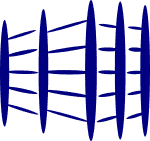Scenario 1
In the warehousing environment, there is always the problem of productivity.
How can you track the productivity of our operational staffs? Do you know how long they have been working in a particular process or activity? Are there any records on the number of cartons being processed within that time?
People always asked these questions. And normally, there isn’t a straightforward answer to it.
One approach is to perform a time motion study.
Firstly, you can generate an average number by recording a number of times on the operator performing the process. This figure is then considered the productivity of the process.
I will agree this is a good way to capture the data required for one process.
However, what happens if the operator is crossed trained to perform multiple tasks? He can perform inbound operations at the beginning of the day. But when help is required, he is moved over to the outbound operations.
How do we then monitor the performance of the staff, especially if the activity does not involved scanning or time stamp?
Currently, as far as I understand, there are a couple of methods.
Method for Calculating Productivity
Method 1: Manually recording by individual staff on the activities done per day. Someone will then collect all the sheets from all the staffs and input into the system.
Pro: Cheapest option
Con: Troublesome, prone to error, require effort from operators
Method 2: Operator to scan his individual card whenever he reaches a new workstation to perform a new task.
Pro: Less troublesome, more accurate data collection, automatic consolidation of data
Con: Every terminal requires a scanner for scanning the card
Method 3: Software tracking system (example Tsheets). Using mobile devices, operators to register and highlight in the software whenever he move from the current station to a new station performing different tasks.
Pro: No prior physical installation required. Operators to use their own devices.
Con: Operator still need to manually key in the job change in the devices.
Recently, there is a new startup company generating buzz in the startup world. Investors are investing 1 million Euro dollars into the company, Timeular for starting up the product Zei.
This particular product has eight faces which you are able to configure beforehand the activity definitions. Subsequently, whenever there is a change in activity, you can rotate the object to the correct facing to represent the new activity.
The changes and data are streamed into the system via Bluetooth (either mobile phone or computer).
How does this benefit the warehouse operations?
- Managers can track the activities of the operator real time.
- No manually recording required. All changes are captured in the system.
- No physical installation of devices necessary.
Improvement area
Right now, the first iteration of the product does not provide an on-board memory. Therefore, area that do not have signal coverage or Bluetooth access will not benefit.
Potential of device
There is definitely a potential in this device.
Scenario 2
Now, imagine you are the warehouse designer. A client is requesting you to do up a warehouse model.
You are charging by the manhours put into the project. How can you prove to your client the number of hours spent in the modeling process?
Rightfully, the current practice should be either manually recording on a piece of paper or electronically inputting into a software.
With the product from Timeular, this recording process will now be a simple rotation of the device.

I am glad to know such effective methods to evaluate the productivity of the warehouse. The warehouse is one of the major links of a supply chain which productivity influence the productivity of the whole supply chain. However, a lot of factor influence the productivity of a warehouse in a diverse way. Use of damaged components in the warehouse is one of such factor which could cause an accident which is associated with subsequent product loss. So, damaged pallets should be replaced with suitable substitutes. Have a look at http://racksourceinc.com/products.html